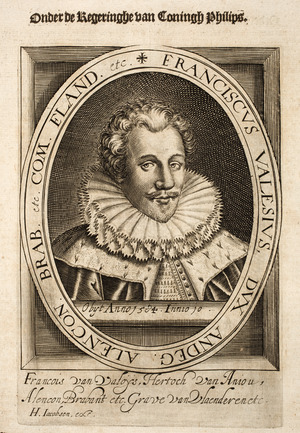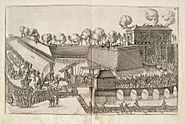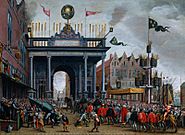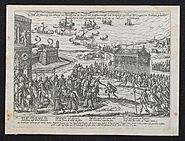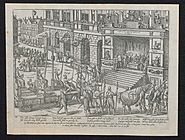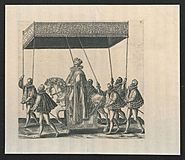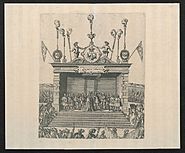Francis, Duke of Anjou facts for kids
Quick facts for kids Francis |
|||||
|---|---|---|---|---|---|
| Duke of Alençon, Château-Thierry, Anjou, Berry, and Touraine | |||||

The Duke in 1572
|
|||||
| Born | 18 March 1555 | ||||
| Died | 10 June 1584 (aged 29) | ||||
| Burial | 27 June 1584 Basilica of St Denis, France |
||||
|
|||||
| House | Valois-Angoulême | ||||
| Father | Henry II of France | ||||
| Mother | Catherine de' Medici | ||||
Francis, Duke of Anjou and Alençon (born Hercule François; 18 March 1555 – 10 June 1584) was a French prince. He was the youngest son of King Henry II and Catherine de' Medici. He was also the last of the Valois family to be heir to the French throne.
Contents
Early Life and Royal Status
How Francis Got His Name
When Francis was eight years old, he got smallpox. This illness left marks on his face and slightly changed his spine. Because of this, his birth name, Hercule (which means strong), did not seem to fit him. When he was confirmed in the Christian faith, he changed his name to Francis. He chose this name to honor his older brother, Francis II of France, who had passed away.
Growing Up in the Royal Family
Francis and his royal brothers and sisters were raised by special guardians. These guardians followed the instructions of Diane de Poitiers, a close advisor to the King.
Becoming Heir to the Throne
In 1574, Francis's brother, Charles IX of France, died. His other brother, Henry III of France, then became king. Since Henry III had no children, Francis became the next in line to the throne. In 1576, he was given important titles like Duke of Anjou, Touraine, and Berry.
Francis and the French Wars of Religion
Joining the Protestant Side
In 1575, Francis left the French court. He had disagreements with his brother, King Henry III. Both the King and their mother, Catherine de' Medici, worried that Francis would join the Protestant rebels. These fears came true. Francis joined forces with Prince Condé and his Protestant army in the south of France.
The "Peace of Monsieur"
In 1576, the King of Navarre also escaped from the French court and joined Condé's army. This combined force was strong enough to make King Henry III agree to a peace treaty. This treaty, called the "peace of Monsieur" or Edict of Beaulieu, was signed on 6 May 1576. It gave many benefits to the Protestants. As part of this peace, Francis was given the Duchy of Anjou and other lands, becoming the Duke of Anjou.
Courting Queen Elizabeth I of England
A Royal Match?
In 1579, talks began about Francis marrying Elizabeth I of England. Francis was the only foreign prince who traveled to England to meet Elizabeth in person. He was 24 years old, and Elizabeth was 46. Even with the age difference, they became quite close. Elizabeth even called him her "frog." Some people think this was because of a frog-shaped earring he gave her. Others believe "frog" was a common, sometimes teasing, nickname for the French back then.
Was Marriage Possible?
It is still debated whether Elizabeth truly planned to marry Francis. She seemed to like him a lot, knowing he might be her last chance to marry. However, many English people did not like the idea. English Protestants worried about the Queen marrying a French Catholic. They called Francis's mother, Catherine de' Medici, "Jezebel," a very strong insult.
Most of Elizabeth's advisors, like Robert Dudley, 1st Earl of Leicester, and Sir Francis Walsingham, were strongly against the marriage. They worried about Elizabeth's age and the risks of having children. They also feared that if Elizabeth died while married to Francis, France might try to control England.
The End of the Engagement
Elizabeth eventually decided that the marriage was not a good idea. She listened to her advisors, who were strongly against it. However, she continued to act as if the engagement might happen. This was a clever way to warn Philip II of Spain, another suitor, about what she might do. Finally, Elizabeth said goodbye to Francis in 1581. She even wrote a poem called "On Monsieur's Departure" about his leaving.
Francis in the Netherlands
Becoming a Protector
After leaving England, Francis went to the Netherlands. In 1579, William the Silent invited him to become the ruler of the United Provinces. In 1580, the Dutch States General agreed to this. Francis was given the title "Protector of the Liberty of the Netherlands." He arrived in February 1582 and was welcomed with grand ceremonies in cities like Bruges and Ghent. He was also made Duke of Brabant and Count of Flanders.
Unpopular Rule
Despite the grand welcomes, Francis was not popular with the Dutch and Flemish people. They still saw the Catholic French as enemies. Two important provinces, Zeeland and Holland, refused to accept him as their ruler. William the Silent, who tried to ease religious tensions, was criticized for his "French politics."
-
Joyous Entry in Antwerp on 19 February 1582 (Rijksmuseum Amsterdam)
-
A satirical painting from around 1586. It shows a cow representing the Dutch provinces. King Philip II of Spain tries to ride it, while Queen Elizabeth I feeds it. William of Orange holds its horns, and the Duke of Anjou holds its tail. (Toronto Public Library)
The French Fury
Francis was not happy with his limited power. He decided to take control of several Flemish cities by force, including Antwerp. He planned a "Joyous Entry" into Antwerp, a grand parade with his French troops, to trick the citizens. On 18 January 1583, Francis entered Antwerp. However, the citizens were not fooled. The city's militia attacked and defeated Francis's army in an event known as the French Fury. Francis barely escaped with his life.
Later Life and Death
The disaster at Antwerp ended Francis's military career. His mother, Catherine de' Medici, was very upset. Queen Elizabeth I also officially ended her engagement to him after the attack. Francis's position in the Netherlands became impossible, and he left the country in June 1583.
Soon after, Francis became very ill with malaria. His mother brought him back to Paris. In February 1584, he made peace with his brother, King Henry III of France. Henry had once called him le petit magot ("little monkey"), but now embraced him. Francis died in June 1584, at the age of 29. His early death meant that the Protestant Henry of Navarre became the next in line to the French throne. This led to more intense French Wars of Religion.
Titles Held by Francis
- 1560–1584: Duke of Évreux
- 1566–1584: Duke of Alençon; Duke of Château-Thierry; Count of Perche; Count of Meulan; Count of Mantes
- 1576–1584: Duke of Anjou; Duke of Berry; Duke of Touraine
- 1580–1584: Lord of the Netherlands
- 1582–1584: Duke of Brabant, Count of Flanders
See also
 In Spanish: Francisco de Anjou para niños
In Spanish: Francisco de Anjou para niños


